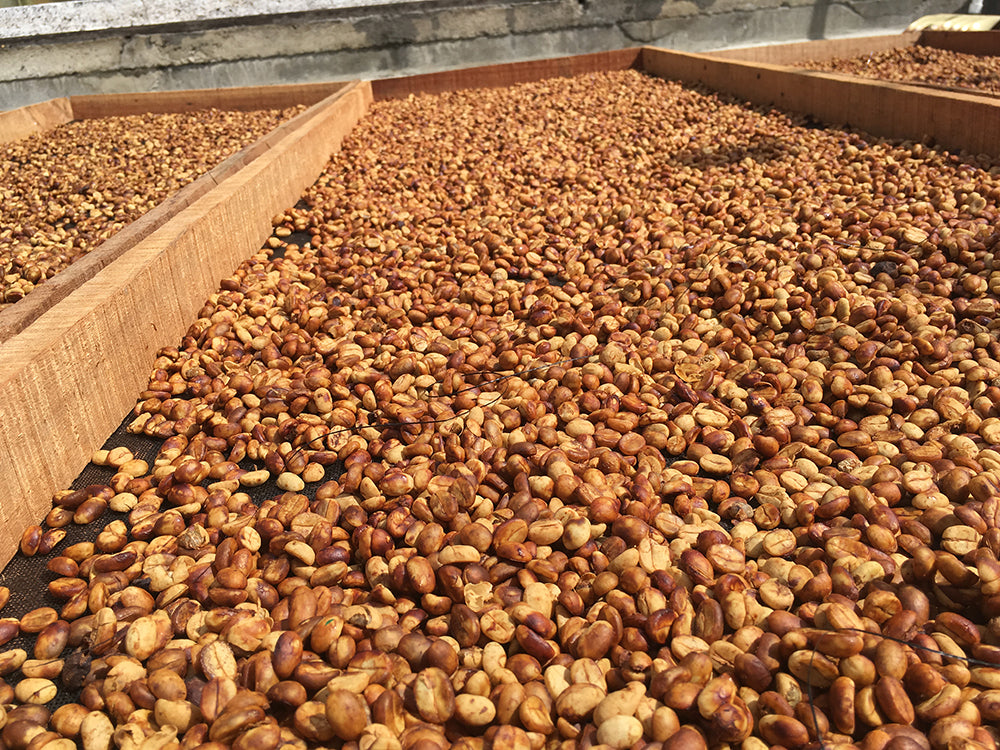Processing Explained – Washed, Natural, Honey

It is a very exciting time for specialty coffee. As technology advances and new techniques and ideas are made available to everyone instantaneously, we are seeing huge change in our not-so niche area of the market. Now, like ever before, we are seeing producers diversify their crops; new varietals are being developed and planted, different harvesting methods (both mechanical and non-mechanical) are being introduced, but perhaps the biggest change is happening in the form of processing techniques. Countries like Colombia for instance (which traditionally produces strictly washed coffee) has been coming out with naturals, honeys and everything in between in an effort to engage with the increasing consumer demand for something different. Emerging specialty producing nations such as Burundi and Rwanda are also jumping on the bandwagon with natural processing (check out our Remera natural). But what do these methods entail exactly? What is the difference in your morning cup? This article is designed as an entry level guide into the increasingly complex world of coffee processing.
Washed
Washed process is the most common processing method there is. It involves the removal of the flesh from the coffee cherry and soaking it for a pre-determined period of time; longer soaking periods allow for increased fermentation (potentially more complex flavour but at the risk of defects). The coffee is then pushed through a series of channels to essentially ‘scrub’ away any remaining mucilage (the coffee’s sticky membrane). After the ‘washing’ is complete, the coffee is then laid out either on patios or raised beds to dry to around 12-13% moisture content. Once dry the coffee is packed into sacks and sent to the dry mill to have the outer layer (parchment) removed and for further sorting. In the cup washed coffee presents a very ‘clean’ and generally higher acidity than other processing methods.
Pros: Clear acidity, (generally) easier to roast, allows terroir and varietal characteristic to shine.
Cons: Flavours can get lost in milk-based coffees, uses a lot of water (not suitable for countries with little rainfall), water can be harmful to the environment if not treated properly afterwards.
Natural
Natural processing involves simply laying the whole ripe coffee cherries out on patios or raised beds and allowing them to dry in the sun for a period of time. Depending on the weather, this process can take anywhere from 1-4 weeks for the coffee to fully dry; some techniques can even allow the drying process to be extended even further.
Drying with the flesh still on increases the amount of sugars absorbed by the seed, however they must be turned regularly to avoid over-fermentation; if a great deal of care is not taken it may result in increased levels of acetic acid (vinegar), a very undesirable trait in coffee. Once dry the flesh is removed and the coffee sent (in parchment) to the dry mill for further sorting.
In the cup, naturals generally display sweet and fruity characteristics (commonly berries and tropical fruits). Natural flavours tend to present on a spectrum of intensity from barely perceptible to overwhelmingly intense (the intensity is linked to the level of fermentation applied). Natural processed coffees can be quite divisive and many people shun them entirely.
Pros: Increased sweetness and added fruit characteristics, environmentally friendly with no water wastage or pollution.
Cons: Acidity and terroir/varietal characters can be muted or lost, (generally) harder to roast, hard to produce in countries with unpredictable rainfall, higher risk of defects associated with over-fermentation.
Honey/Pulped Natural
Honey processing operates in the grey area between the washed and natural processes. It involves the removal of the cherry’s flesh but forgoes the subsequent washing.
The result is a balance of acidity, sweetness and cleanliness that sits somewhere between washed and natural. Honey processing is far from an exact science and there are many variations on the technique. Usually these variations are associated with the amount of flesh/mucilage left clinging to the seed and are identified by a colour indicator; the spectrum starts at ‘white honey’ (meaning a very small amount of flesh left on) all the way to ‘black honey’ (lots of flesh left on) with ‘yellow’ and ‘red’ representing the levels in between.
As with naturals the more flesh left on, the greater the risk of over-fermentation and acetic acid becoming prevalent. The pulped natural process (most commonly used in Brazil) is essentially a honey process similar to ‘red honey’ however the machinery used utilises water to assist in the removal of the mucilage.
As pulped natural is a wide-spread technique there are no strict guidelines as to the exact amount of mucilage left on and this varies from place to place. In the cup honeys present the best (or worst depending on your perspective) of both worlds. They can have a nice balance of sweetness, acidity, cleanliness and flavour characteristics if done well and are, in many cases, less risky than naturals; many people however will tend to prefer one of either washed or natural coffee and will tend to shy away from the compromise that honeys offer.
Pros: Well-balanced in the cup, very versatile in the production phase and can be varied to produce different effects in the resulting cup.
Cons: Acidity and cleanliness will often not be as good as a washed, sweetness and fruit characteristics will often not be as good as a natural, essentially a jack-of-all-trades coffee but master of none.
As I final note, it is important to point out that, at the end of the day, coffee tasting is an entirely subjective process and every individual has their own personal preferences. The above information is intended as a general guide to assist in choosing the best coffee for your tastes; it is not intended to be taken as gospel. With the size and scope of the coffee industry it would be nearly impossible to categorise all the variations in processing methods and, likewise, to paint them all with the same brush.

